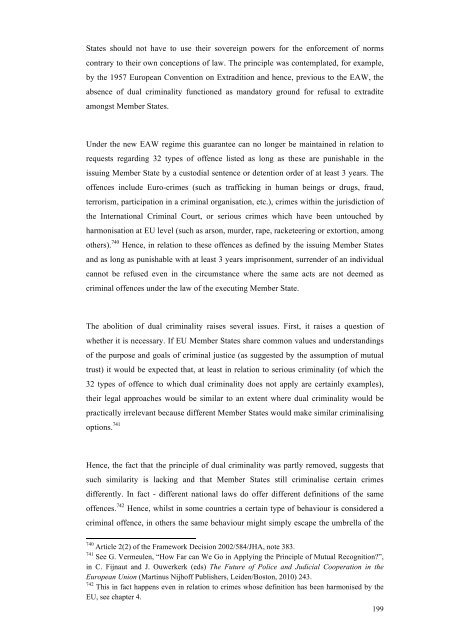The evolution of European Union criminal law (1957-2012)
The evolution of European Union criminal law (1957-2012)
The evolution of European Union criminal law (1957-2012)
You also want an ePaper? Increase the reach of your titles
YUMPU automatically turns print PDFs into web optimized ePapers that Google loves.
States should not have to use their sovereign powers for the enforcement <strong>of</strong> norms<br />
contrary to their own conceptions <strong>of</strong> <strong>law</strong>. <strong>The</strong> principle was contemplated, for example,<br />
by the <strong>1957</strong> <strong>European</strong> Convention on Extradition and hence, previous to the EAW, the<br />
absence <strong>of</strong> dual <strong>criminal</strong>ity functioned as mandatory ground for refusal to extradite<br />
amongst Member States.<br />
Under the new EAW regime this guarantee can no longer be maintained in relation to<br />
requests regarding 32 types <strong>of</strong> <strong>of</strong>fence listed as long as these are punishable in the<br />
issuing Member State by a custodial sentence or detention order <strong>of</strong> at least 3 years. <strong>The</strong><br />
<strong>of</strong>fences include Euro-crimes (such as trafficking in human beings or drugs, fraud,<br />
terrorism, participation in a <strong>criminal</strong> organisation, etc.), crimes within the jurisdiction <strong>of</strong><br />
the International Criminal Court, or serious crimes which have been untouched by<br />
harmonisation at EU level (such as arson, murder, rape, racketeering or extortion, among<br />
others). 740 Hence, in relation to these <strong>of</strong>fences as defined by the issuing Member States<br />
and as long as punishable with at least 3 years imprisonment, surrender <strong>of</strong> an individual<br />
cannot be refused even in the circumstance where the same acts are not deemed as<br />
<strong>criminal</strong> <strong>of</strong>fences under the <strong>law</strong> <strong>of</strong> the executing Member State.<br />
<strong>The</strong> abolition <strong>of</strong> dual <strong>criminal</strong>ity raises several issues. First, it raises a question <strong>of</strong><br />
whether it is necessary. If EU Member States share common values and understandings<br />
<strong>of</strong> the purpose and goals <strong>of</strong> <strong>criminal</strong> justice (as suggested by the assumption <strong>of</strong> mutual<br />
trust) it would be expected that, at least in relation to serious <strong>criminal</strong>ity (<strong>of</strong> which the<br />
32 types <strong>of</strong> <strong>of</strong>fence to which dual <strong>criminal</strong>ity does not apply are certainly examples),<br />
their legal approaches would be similar to an extent where dual <strong>criminal</strong>ity would be<br />
practically irrelevant because different Member States would make similar <strong>criminal</strong>ising<br />
options. 741<br />
Hence, the fact that the principle <strong>of</strong> dual <strong>criminal</strong>ity was partly removed, suggests that<br />
such similarity is lacking and that Member States still <strong>criminal</strong>ise certain crimes<br />
differently. In fact - different national <strong>law</strong>s do <strong>of</strong>fer different definitions <strong>of</strong> the same<br />
<strong>of</strong>fences. 742 Hence, whilst in some countries a certain type <strong>of</strong> behaviour is considered a<br />
<strong>criminal</strong> <strong>of</strong>fence, in others the same behaviour might simply escape the umbrella <strong>of</strong> the<br />
740 Article 2(2) <strong>of</strong> the Framework Decision 2002/584/JHA, note 383.<br />
741 See G. Vermeulen, “How Far can We Go in Applying the Principle <strong>of</strong> Mutual Recognition”,<br />
in C. Fijnaut and J. Ouwerkerk (eds) <strong>The</strong> Future <strong>of</strong> Police and Judicial Cooperation in the<br />
<strong>European</strong> <strong>Union</strong> (Martinus Nijh<strong>of</strong>f Publishers, Leiden/Boston, 2010) 243.<br />
742 This in fact happens even in relation to crimes whose definition has been harmonised by the<br />
EU, see chapter 4.<br />
199
















